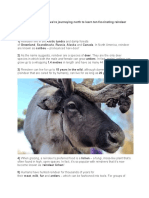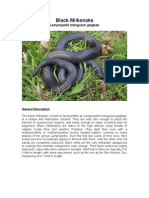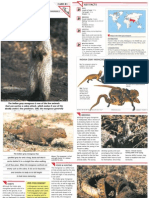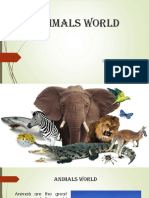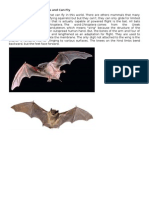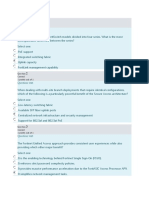Giraffe
Giraffe
Uploaded by
ringpieceCopyright:
Available Formats
Giraffe
Giraffe
Uploaded by
ringpieceOriginal Description:
Copyright
Available Formats
Share this document
Did you find this document useful?
Is this content inappropriate?
Copyright:
Available Formats
Giraffe
Giraffe
Uploaded by
ringpieceCopyright:
Available Formats
GIRAFFE FACT SHEET
STATUS: Vulnerable. DESCRIPTION: Giraffes are one of the world's tallest mammals. They are well known for their long necks, long legs, and spotted patterns. Giraffes have small "horns" or knobs on top of their heads that grow to be about five inches long. These knobs are used to protect the head in fights. SIZE: Male giraffes are larger than females. Males weigh between 2,400 and 3,000 pounds and stand up to 19 feet tall. Female giraffes weigh between 1,600 and 2,600 pounds and grow to be 16 feet tall. POPULATION: Giraffe populations are relatively stable. LIFESPAN: Healthy giraffes live about 25 years in the wild. RANGE: Giraffes can be found in central, eastern and southern Africa. HABITAT: Giraffes live in the savannas of Africa, where they roam freely among the tall trees, arid land, dense forests and open plains. FOOD: Their long necks help giraffes eat leaves from tall trees, typically acacia trees. If they need to, giraffes can go for several days without water. Instead of drinking, giraffes stay hydrated by the moisture from leaves. BEHAVIOR: Giraffes are non-territorial, social animals. They travel in large herds that are not organized in any way. Herds may consist of any combination of sexes or ages. OFFSPRING: Female giraffes typically give birth to one calf after a fifteen-month gestation period. During the first week of its life, the mother carefully guards her calf. Young giraffes are very vulnerable and cannot defend themselves. While mothers feed, the young are kept in small nursery groups.
CHARACTERISTICS: Giraffes have spots covering their entire bodies, except their underbellies, with each giraffe having a unique pattern of spots. Giraffes have long necks, which they use to browse the leaves of trees. They also have slightly elongated forelegs, about 10% longer than their hind legs. Like nearly all mammals, a giraffe has seven neck vertebrae, which are extremely elongated. These bones produce bud like horns called ossicorns. Modifications to the giraffe's structure have evolved, particularly to the circulatory system. A giraffe's heart, which can weigh up to 10 kg (24 lb), has to generate around double the normal blood pressure for a large mammal in order to maintain blood flow to the brain against gravity. In the upper neck, a complex pressure regulation system called the rete mirabile prevents excess blood flow to the brain when the giraffe lowers its head to drink. Conversely, the blood vessels in the lower legs are under great pressure (because of the weight of fluid pressing down on them). In other animals such pressure would force the blood out through the capillary walls; giraffes, however, have a very tight sheath of thick skin over their lower limbs which maintains high extravascular pressure in exactly the same way as a pilot's g suit. Male giraffes determine female fertility by tasting the female's urine to detect estrus in a multi step process known as the Flehmen response. Giraffe gestation lasts between 14 and 15 months, after which a single calf is born. The mother gives birth standing up and the embryonic sack actually bursts when the baby falls to the ground. Newborn giraffes are about 1.8 meters tall. Within a few hours of being born, calves can run around and are indistinguishable from a week old calf; however, for the first two weeks, they spend most of their time lying down, guarded by the mother. While adult giraffes are too large to be attacked by most predators, the young can fall prey to lions, leopards, hyenas, and African Wild Dogs. It has been speculated that their characteristic spotted pattern provides a certain degree of camouflage. Only 25 to 50% of giraffe calves reach adulthood; the life expectancy is between 20 and 25 years in the wild and 28 years in captivity. The giraffe browses on the twigs of trees, preferring plants of the Mimosa genus; but it appears that it can, without inconvenience, live on other vegetable food. A giraffe can eat 63 kg (140 lb) of leaves and twigs daily. The pace of the giraffe is an amble, though when pursued it can run extremely fast. It cannot sustain a lengthened chase. Its leg length compels an unusual gait with the left legs moving together followed by right (similar to pacing) at low speed, and the back legs crossing outside the front at high speed. The giraffe defends itself against threats by kicking with great force. A single well placed kick of an adult giraffe can shatter a lion's skull or break its spine. The giraffe has one of the shortest sleep requirements of any mammal, which is between 20 minutes and two hours in a 24 hour period. A giraffe will clean off any bugs that appear on its face with its extremely long tongue (about 18 inches). The tongue is tough on account of the giraffe's diet, which includes thorns from the tree it is making a meal of. In Southern Africa, giraffes are partial to all acacias especially Acacia erioloba and possess a specially adapted tongue and lips that appear to be immune to the vicious thorns. Giraffes are thought to be mute. However, recent research has shown evidence that the animal communicates at an infrasound level. THREATS: Giraffes are hunted for their meat, coat and tails. The tail is prized for good luck bracelets, fly whisks and string for sewing beads. The coat is used for shield coverings. Habitat destruction and fragmentation are also threats to giraffe populations. CAPTIVITY: Animals used in the circus spend the majority of the year imprisoned in small cages or on chains, traveling from show to show. The training endured by circus animals is almost always based on intimidation; trainers must break the spirit of the animals in order to control them. While zoos and aquariums may appear to be educational and conservation-oriented, most are designed with the needs and desires of the visitors in mind, not the needs of the animals. Many animals in zoos and aquariums exhibit abnormal behavior as a result of being deprived of their natural environments and social structures. Some zoos and aquariums do rescue some animals and work to save endangered species, but most animals in zoos were either captured from the wild or bred in captivity for the purpose of public display, not species protection. The vast majority of captive-bred animals will never be returned to the wild. When the facility breeds too many animals they become "surplus" and often are sold to laboratories, traveling shows, shooting ranches, or to private individuals who may be unqualified to care for them. PROTECTION: No current protective laws.
You might also like
- Hose Products and Tooling Guide 8th EditionDocument332 pagesHose Products and Tooling Guide 8th EditionKeron Trotz100% (4)
- Observations On Birth and Early Development of The Spotted HyenaDocument1 pageObservations On Birth and Early Development of The Spotted HyenaWy GnoixNo ratings yet
- Grzimek's Animal Life EncyclopediaDocument2 pagesGrzimek's Animal Life Encyclopediamaximilijan7No ratings yet
- Tigers SensesDocument5 pagesTigers SensespaidalaNo ratings yet
- Splunk-7 2 1-IndexerDocument446 pagesSplunk-7 2 1-IndexerRaghavNo ratings yet
- ReptilesDocument36 pagesReptilesArabelle Da FirstNo ratings yet
- ReptilesDocument9 pagesReptilesakrivohlavkovaemail.czNo ratings yet
- ZB Tigers 34-18-SMDocument20 pagesZB Tigers 34-18-SMshehla tahirNo ratings yet
- Parelhoenders in Handbook of The Birds of The World 01Document21 pagesParelhoenders in Handbook of The Birds of The World 01Alyssa LeonidoNo ratings yet
- ZOOBGiraffesDocument32 pagesZOOBGiraffesIstvan DanielNo ratings yet
- Birds SlidesDocument24 pagesBirds SlidesPETER OSIAKONo ratings yet
- ZOOBBatsDocument26 pagesZOOBBatsIstvan DanielNo ratings yet
- Animals Found in Antarctic ADocument5 pagesAnimals Found in Antarctic AAndrea CabreraNo ratings yet
- Lions: Kings of the Jungle (Wildlife Big Cats): Big Cats EncyclopediaFrom EverandLions: Kings of the Jungle (Wildlife Big Cats): Big Cats EncyclopediaNo ratings yet
- Facts About ReindeersDocument3 pagesFacts About ReindeersAlexandra HellAngelNo ratings yet
- Ducks For Kids: Amazing Animal Books For Young ReadersFrom EverandDucks For Kids: Amazing Animal Books For Young ReadersRating: 4 out of 5 stars4/5 (1)
- Presentation - PPTX Inland TaipanDocument11 pagesPresentation - PPTX Inland TaipanrobNo ratings yet
- Monkeys:Facts You May Not KnowDocument8 pagesMonkeys:Facts You May Not KnowivanmvNo ratings yet
- TigerDocument27 pagesTigerMsKarolyNo ratings yet
- Chapter 2 Snakes of Papua New GuineaDocument23 pagesChapter 2 Snakes of Papua New GuineaIrfan Haidar BasyirNo ratings yet
- Plan and Animals in AustraliaDocument8 pagesPlan and Animals in AustraliaLeah & ZenithNo ratings yet
- Wildlife Fact File - Mammals - Pgs. 31-40Document20 pagesWildlife Fact File - Mammals - Pgs. 31-40ClearMind84100% (4)
- Ilovepdf Merged 17Document148 pagesIlovepdf Merged 17FournierNo ratings yet
- Ict AnimalDocument5 pagesIct Animalapi-307983595No ratings yet
- Black Milksnake CaresheetDocument3 pagesBlack Milksnake CaresheetNathaniel GodinNo ratings yet
- Mammals ppt-1Document10 pagesMammals ppt-1api-309894157No ratings yet
- Wildlife Fact File - Mammals - Pgs. 81-90Document20 pagesWildlife Fact File - Mammals - Pgs. 81-90ClearMind8475% (4)
- Многообразие На Птиците - Copy en-USDocument15 pagesМногообразие На Птиците - Copy en-USNikolay KolevNo ratings yet
- SealszoobookDocument10 pagesSealszoobookapi-239364834100% (1)
- Wildlife Fact File - Birds - Pgs. 161-170Document20 pagesWildlife Fact File - Birds - Pgs. 161-170ClearMind84100% (1)
- Reptiles - Snakes - Python Fact SheetDocument2 pagesReptiles - Snakes - Python Fact SheetUwaisNo ratings yet
- Amur LeopardDocument15 pagesAmur LeopardLS WongNo ratings yet
- Photos of Common Fishes in The Lower Mekong River 20 June 2016Document102 pagesPhotos of Common Fishes in The Lower Mekong River 20 June 2016Naughty VongNo ratings yet
- Burns Grace AnimalsDocument8 pagesBurns Grace Animalsapi-285108029No ratings yet
- Clouded Leopard StudbookDocument63 pagesClouded Leopard StudbookToha PutraNo ratings yet
- Tiger Paper EnglishDocument9 pagesTiger Paper EnglishAndrea TariganNo ratings yet
- Wildlife of IndiaDocument22 pagesWildlife of IndiaAkshat SharmaNo ratings yet
- Animals World: By: Kathleen ChavezDocument60 pagesAnimals World: By: Kathleen ChavezMendez Justine KurtNo ratings yet
- Marine BiologyDocument25 pagesMarine Biologyapi-348512756No ratings yet
- A253 Carnivora - 105 Low RezDocument1 pageA253 Carnivora - 105 Low RezMAnsi CHoukseyNo ratings yet
- Care Sheet - Carpet PythonDocument2 pagesCare Sheet - Carpet PythonJohn GamesbyNo ratings yet
- Snakes in India - Tradition and The Truth PDFDocument5 pagesSnakes in India - Tradition and The Truth PDFhoticeforuNo ratings yet
- Kayla Soen - Unit 2 - Non - Chronological ReportDocument3 pagesKayla Soen - Unit 2 - Non - Chronological ReportKayla SoenNo ratings yet
- The History of ZoosDocument12 pagesThe History of Zoosapi-217602889100% (1)
- Ice Age Spotted HyenaDocument3 pagesIce Age Spotted Hyenaapi-296974308No ratings yet
- Mammals That Have Wings and Can FlyDocument3 pagesMammals That Have Wings and Can FlyrapaseNo ratings yet
- Wildlife Fact File - Reptiles - Pgs. 11-20Document18 pagesWildlife Fact File - Reptiles - Pgs. 11-20ClearMind84100% (1)
- Tiger: This Article Is About The Big Cat. For Other Uses, See - "Tigress" Redirects Here. For Other Uses, SeeDocument39 pagesTiger: This Article Is About The Big Cat. For Other Uses, See - "Tigress" Redirects Here. For Other Uses, SeeSharmistha Talukder Khastagir100% (1)
- Endemic BirdsDocument74 pagesEndemic BirdsGEETA BHANDARI100% (1)
- Needs of Mammals PowerpointDocument18 pagesNeeds of Mammals PowerpointJake WidowNo ratings yet
- Handbook For Pit Bull AdoptersDocument10 pagesHandbook For Pit Bull AdoptersringpieceNo ratings yet
- COMMON NAME: Common CarpDocument3 pagesCOMMON NAME: Common CarpringpieceNo ratings yet
- The Carnivore Connection To Nutrition in Cats - Feeding Your CatDocument0 pagesThe Carnivore Connection To Nutrition in Cats - Feeding Your CatringpieceNo ratings yet
- Equids Zebras, Asses and Horses - IUCNDocument204 pagesEquids Zebras, Asses and Horses - IUCNringpieceNo ratings yet
- Ostrich Production: Joe BerryDocument4 pagesOstrich Production: Joe BerryringpieceNo ratings yet
- The Cane Toad: HistoryDocument2 pagesThe Cane Toad: HistoryringpieceNo ratings yet
- Box Jellyfish Antivenom: Before You Are Given ItDocument1 pageBox Jellyfish Antivenom: Before You Are Given ItringpieceNo ratings yet
- Colossal Squid Timeline: Diorama ActivitiesDocument2 pagesColossal Squid Timeline: Diorama ActivitiesringpieceNo ratings yet
- The Portuguese Man of WarDocument5 pagesThe Portuguese Man of WarringpieceNo ratings yet
- Box Jellyfish EvolutionDocument3 pagesBox Jellyfish EvolutionringpieceNo ratings yet
- Box Jellyfish at KwajDocument4 pagesBox Jellyfish at KwajringpieceNo ratings yet
- Box Jellyfish CMI - Dec08Document2 pagesBox Jellyfish CMI - Dec08ringpieceNo ratings yet
- Chironex Fleckeri (Box Jellyfish)Document2 pagesChironex Fleckeri (Box Jellyfish)ringpieceNo ratings yet
- Chironex Fleckeri - The North Australian Box-JellyfishDocument0 pagesChironex Fleckeri - The North Australian Box-JellyfishringpieceNo ratings yet
- Current Biology 2011 GarmDocument6 pagesCurrent Biology 2011 GarmringpieceNo ratings yet
- Siberian Tiger (Amur Tiger) Panthera Tigris Altacia Geographical RangeDocument1 pageSiberian Tiger (Amur Tiger) Panthera Tigris Altacia Geographical RangeringpieceNo ratings yet
- Elephants Don't Play ChessDocument12 pagesElephants Don't Play ChessringpieceNo ratings yet
- GerbilDocument2 pagesGerbilringpieceNo ratings yet
- Section 3-10: Variation of Parameters: Pty Qty Rty GTDocument8 pagesSection 3-10: Variation of Parameters: Pty Qty Rty GTMs. B.B.U.P. Perera - University of KelaniyaNo ratings yet
- Question Text: Correct 1 Points Out of 1Document4 pagesQuestion Text: Correct 1 Points Out of 1gurungeNo ratings yet
- Facilities Maintenance CourseDocument44 pagesFacilities Maintenance CourseEhab RedaNo ratings yet
- Ucpb vs. AboitizDocument5 pagesUcpb vs. AboitizTinersNo ratings yet
- Els-003 LH Options Guide FinalDocument31 pagesEls-003 LH Options Guide FinaltilahunbejigoNo ratings yet
- Case 224 Kethavath Naresh Vs Amazon Seller Services Private Limited and Anr 505734Document8 pagesCase 224 Kethavath Naresh Vs Amazon Seller Services Private Limited and Anr 505734Khushi SalujaNo ratings yet
- Brian Walker: Work ExperienceDocument3 pagesBrian Walker: Work ExperiencetransNo ratings yet
- TBII ReleaseInformation V6.00 ENG-M3E-013-1 PDFDocument4 pagesTBII ReleaseInformation V6.00 ENG-M3E-013-1 PDFLuis VillarroelNo ratings yet
- Conjunctions: Grammar Boot Camp Round 5Document7 pagesConjunctions: Grammar Boot Camp Round 5Encio BonillaNo ratings yet
- Performance Appraisal in AIRTELDocument73 pagesPerformance Appraisal in AIRTELPRIYA RANANo ratings yet
- (Chapter 2) Sol Man of Intermediate Accounting 2 by Zeus MillanDocument17 pages(Chapter 2) Sol Man of Intermediate Accounting 2 by Zeus MillanJonathan Villazon RosalesNo ratings yet
- Emerging and Reemerging Infectious DiseasesDocument13 pagesEmerging and Reemerging Infectious DiseasesSayu100% (1)
- The Review of Victoria Fromkin and Robert RodmanDocument13 pagesThe Review of Victoria Fromkin and Robert RodmanAnayoNo ratings yet
- Importance of OrganisingDocument8 pagesImportance of OrganisingchaimaNo ratings yet
- The Post - 2009 Freshman GuideDocument24 pagesThe Post - 2009 Freshman GuideBrock FowlerNo ratings yet
- Review of Related Study and LiteratureDocument4 pagesReview of Related Study and LiteratureRyan Carl IbarraNo ratings yet
- Gravitation Insp Champs 2024Document15 pagesGravitation Insp Champs 2024manjumalik125No ratings yet
- Achievement Test #5 (Động Từ Khiếm Khuyết Và Gerund & Infinitive) (Key)Document5 pagesAchievement Test #5 (Động Từ Khiếm Khuyết Và Gerund & Infinitive) (Key)RioPhanNo ratings yet
- Module 2 English For International EmploymentDocument4 pagesModule 2 English For International EmploymentGalvez, Princess May J.No ratings yet
- Steel Structure SheduleDocument22 pagesSteel Structure SheduleisanNo ratings yet
- BSBHRM613 LR F v1.0Document116 pagesBSBHRM613 LR F v1.0민수학No ratings yet
- Certificate of Registration - Ohs - Sa - 01Document1 pageCertificate of Registration - Ohs - Sa - 01AlokeNo ratings yet
- Department of Business and Industrial ManagementDocument34 pagesDepartment of Business and Industrial ManagementRahul panditaNo ratings yet
- Finance Module 10 Managing Personal FinanceDocument4 pagesFinance Module 10 Managing Personal FinanceKJ JonesNo ratings yet
- SM - Kymco Vitality 50 - Chapter 05 (Engine Installation)Document11 pagesSM - Kymco Vitality 50 - Chapter 05 (Engine Installation)jose sousa oliveiraNo ratings yet
- Layout Melati Mas 2Document2 pagesLayout Melati Mas 2Dhewo BMFNo ratings yet
- DNB Orthopaedics Theory PapersDocument23 pagesDNB Orthopaedics Theory PapersmystraviNo ratings yet
- J&K Drainage System Notes - 45026923 - 2024 - 10 - 20 - 22 - 45Document21 pagesJ&K Drainage System Notes - 45026923 - 2024 - 10 - 20 - 22 - 45TAHIR CHOUDHARYNo ratings yet


















